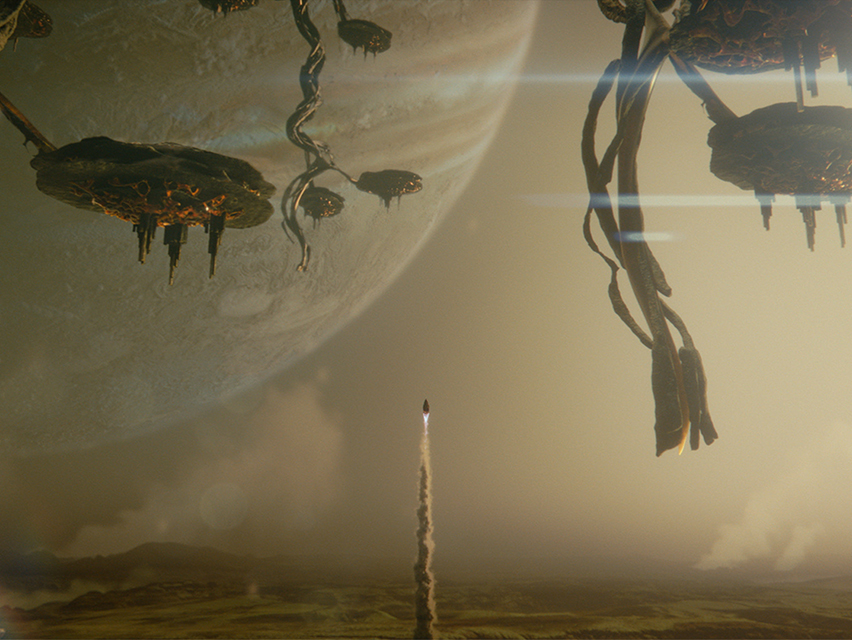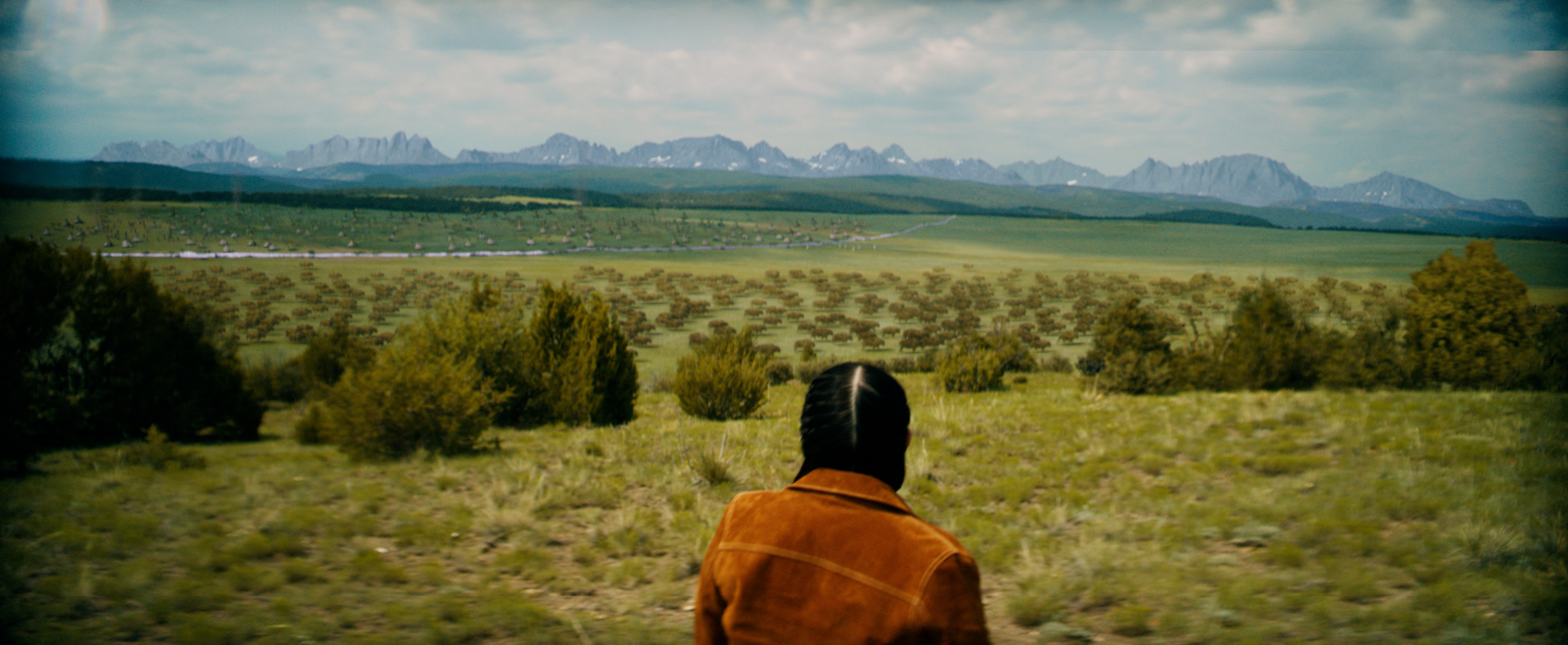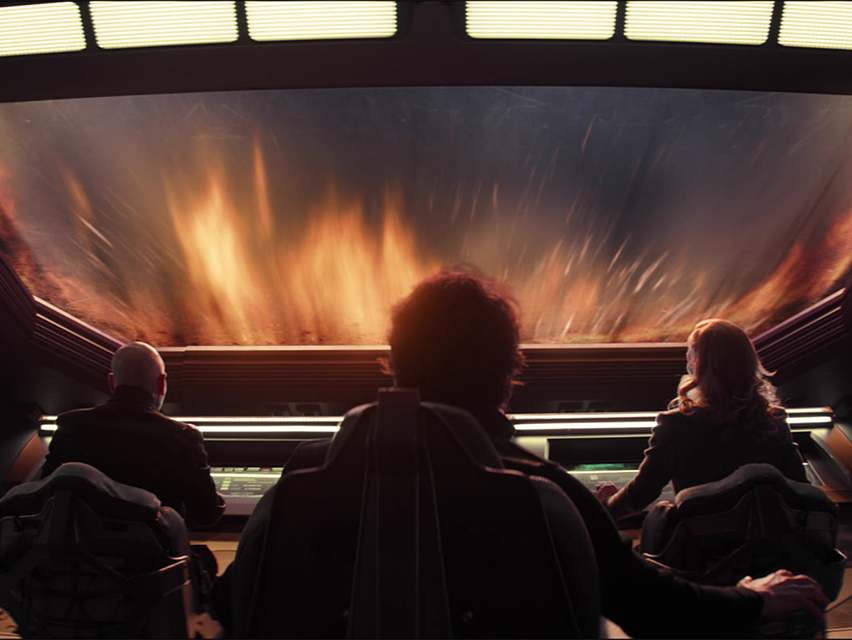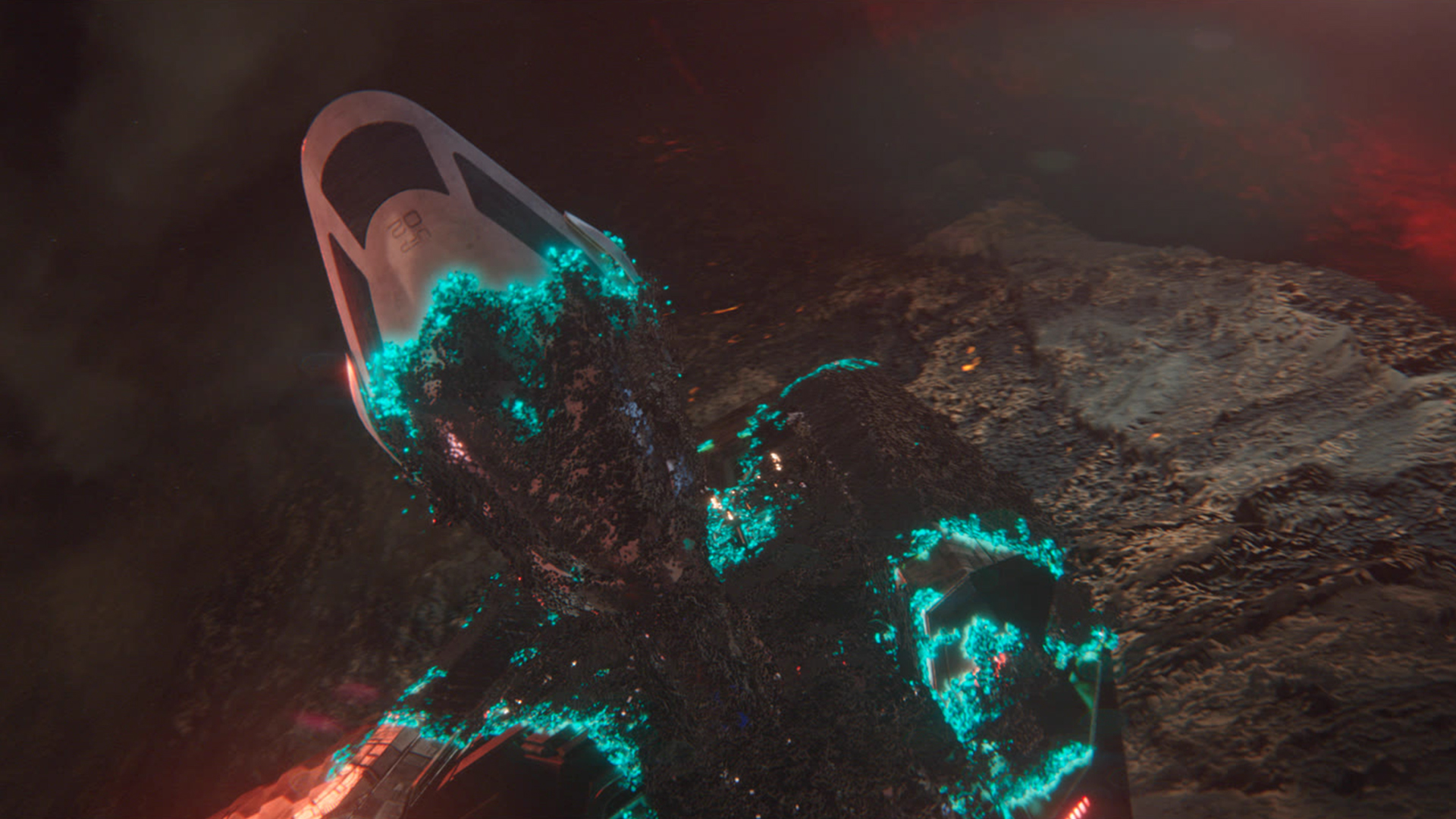Be the first to know — Get Outpost's monthly newsletter for news, tips and job opportunities.

News
The Man Who Fell to Earth: Creating the alien landscape of Anthea
26 August 2022
Outpost's environments team have been hard at work building the complex world of Anthea for Showtime's The Man Who Fell to Earth
Read more about The Man Who Fell to Earth here.
It was clear that extra-terrestrial environments were going to play a key role in Showtime’s 2022 episodic continuation of the film, particularly in communicating the desperate state that planet Anthea was in, as well as helping the audience understand the Anthean species a little better.
Outpost were excited to be awarded almost 150 shots of varying work, including a large number of these outer space environments. We sat down with Lead Generalist Nick White, Senior Environment Artist Maeve Edymann, Mid Environment Artist Borja Gonzalez, and Senior Environment / DMP Artist Chris Hunt to discuss the creative process that went into some of this VFX work.

Planet Anthea and its orbital rings
The Man Who Fell to Earth features vast, high-concept outer space environments, as well as more intimate alien scenes. What was the scope of work for the Outpost environments team?
Nick: We worked on loads of really cool, exciting shots; a lot of which were wide, static, and stylised establishers which contrasted really nicely with the rest of the environments in the show that take place on Earth. We also worked on a couple of smaller, internal environments such as the cavern environment where the Anthean population live.
Despite the shots being static, a lot of our sequences were almost full CG which meant we were able to send the camera around these environments if we needed to, allowing us to offer more flexibility to the clients for the final shot. This included a lot of sculpting and topography for the natural alien landscapes.
The team also did some DMP shots as well as some DMP touch up for shots we knew we wouldn’t need the full CG environments.
Where did you gather reference from for the alien aspects of the series?
Nick: Because the Anthean race is based loosely on bees and a hive culture, we took a lot of reference from insects and the natural world. Although Faraday doesn’t have wings or buzz, he’s essentially a drone within his society, leaving the ‘hive’ as it were to find a way of survival.
So a lot of the design elements come from this idea of the hive and you’ll see a lot of hexagonal shapes tessellating together, as well as twisted and growing shapes that resemble vines or plants.
For the Anthean landscape, we took reference from the Dallol hydrosprings in Ethiopia, located in the hottest place on Earth where highly acidic pools of liquid are brightly coloured due to their high-iron and impurity content. There is no life in the hydrosprings in Dallol because it is an intolerable environment and we wanted to use this to communicate the extreme extent to which Anthea is suffering.

Top down view of the Anthean landscape
The team worked from Outpost Art Director, Steve Molloy’s concept art. Can you talk us through the creative process for this show?
Maeve: For me, there were a couple of things happening in parallel. I was working up a couple of concepts from Steve and [Outpost DMP artist] Lubos Surzin as I started on the project before we had any actual footage, but I was also coming up with full shots because we didn’t have a full brief from the client at that point. That was really fun as I got to be really creative and start shots from scratch. That’s definitely my favourite part of a project; right at the beginning when you have a clean slate to start from.
Nick: It’s kind of like when you’ve bought a new sketchbook and you’re excited with all the possibilities of what you’re going to put in it.
Maeve: Once you’ve gotten over the first page fear! I was also building shots from mood board concepts where there was a little bit of everything in there and I could take one or two elements out and put them into a shot and then take another two and put them into a different shot. There was also a lot of really great pre-vis done by Dimension that was handed over which was a really great jumping off point.
What were some of the technical considerations you had to bear in mind for the creation of environments for The Man Who Fell to Earth?
Borja: The gas giant asset proved to be a technical challenge as it was difficult to create enough detail on the surface of the planet. We used reference images of Jupiter, however they weren’t close enough for us to know what was happening on the surface, and so after looking through NASA imagery, we decided to use a procedural method in Gaea.
Gaea is an incredible procedural software not only for terrains but also for fractal design and its abilities allowed us to create hi-res test displacements that looked like storms and heavy clouds, but it had some limitations.

Faraday and family crossing the desolate Anthea landscape
Using this process meant scale was a challenge. One single sphere has a polygon limit unless you map the displacements with multiple UDIMS or use NURBS spheres. We came up with a system that allowed us to change projections from Equirectangular to six faces from a cube map, since Gaea only works with greyscale maps. Smoothing a cube is the only way to avoid triangles on the poles and we could use six projections with huge maps that could be easily modified.
The second challenge of using this method was to get the soft look of the surface. The different gas fluids moving means subsurface scattering effects. We imagined that heavy, dense clouds moving would generate light storms and maybe fire underneath. In order to do this, we used the new volumetric shaders in Maya.
Maeve: Another challenge we faced was creating an asset that would hold up from such varying distances and making sure the scale at each distance is correct. The Anthea planet itself is 35,000km wide and you need to make sure it looks this big when you have a 2m man in the foreground, and when you’re looking at it from 100m, 500m and so on.
One of our FX artists very early on did a to-scale fly through of the full launch sequence from 2m high off the ground to high into space seeing the massive planet small in screen. That was really helpful for building all the layouts because we could just swap out the sphere for the planet asset, but it also allowed us to identify potential problems as early as possible. We had to answer questions like: how big would a man look on the planet’s surface? How much detail would we need at varying distances? It was quite a unique challenge because it’s not often you’re using an asset across such a vast distance.
With scale in environments on Earth, for example, you’re usually on the ground so you can add a bit of depth haze or put bigger objects in the background and a similar object in the foreground so you can get a sense of relative scale. But in space, there is no depth hazing and instead you have to work with things like framing. When looking at two planets, the camera move can help sell scale by the relative movements of the assets; anything that’s smaller will move quicker. We added things like smaller asteroid rocks into the environment and had these move far quicker in the camera move than the planet behind. It was all about relativity and how things interact with one another.

Faraday leaving the Anthea planet
What tools and processes did you use to create the environments of Anthea?
Nick: For me, Houdini was the ideal tool for this type of work. For generating landscapes, you can get some great work out of the height maps in Houdini really quickly and since a lot of the shots were wide shots, I based it off of height fields to begin with and then run our erosion over the top of that and then we would start to dress that with our 3D assets.
Then, once we had the layout locked in, we’d start with the tafoni and breaking up the assets and giving them more of an alien feel. Initially I was starting by UVing assets and then texturing them in Substance Painter, but because of the flow of the show and the quick progress, I found it was better to work procedurally within Arnold for textures and Maeve set up some shaders.
Maeve: I started with mega scans, so it was never pure CG, as we’d work with textures and procedurally layer them.
Nick: The shaders Maeve built in layout were the basis for the texturing, which meant you don’t have to UV your assets, you don’t have to take it into 3D paint package, you can just put the shader on and it works and its already the right scale.
That was really useful and definitely helped in terms of being able to change tact very quickly. Just having the freedom to do that was really good and so my process became: height fields, 3D geometry and then working things up from there.
Chris: On the environments side, I helped out with the interior cavern design. It was great fun to build, full of incredible alien geology and structure. This was fully sculpted in ZBrush and while this was challenging, due to the sheer scale and detail needed, I was pleased with the way it came together in the end.
Borja: In order to create the continents on Anthea, we used ZBrush. Noise applied to the sphere gave us the perfect procedural shape for the continents and we could add water and acid lakes. So we exported displacements from ZBrush into Gaea with our six cube faced projection system and it allowed us to go seamlessly back and forth from Gaea to ZBrush and vice versa.
We could create destruction and erosion canyon brushes and paint on ZBrush and bring Gaea’s 16-bit displacements into ZBrush for detailing. This way we could get as much detail as we wanted and still keep the continents and the planet structure.
The Man Who Fell to Earth is now available to stream on Paramount+ in the US, and Amazon Prime in the UK.







